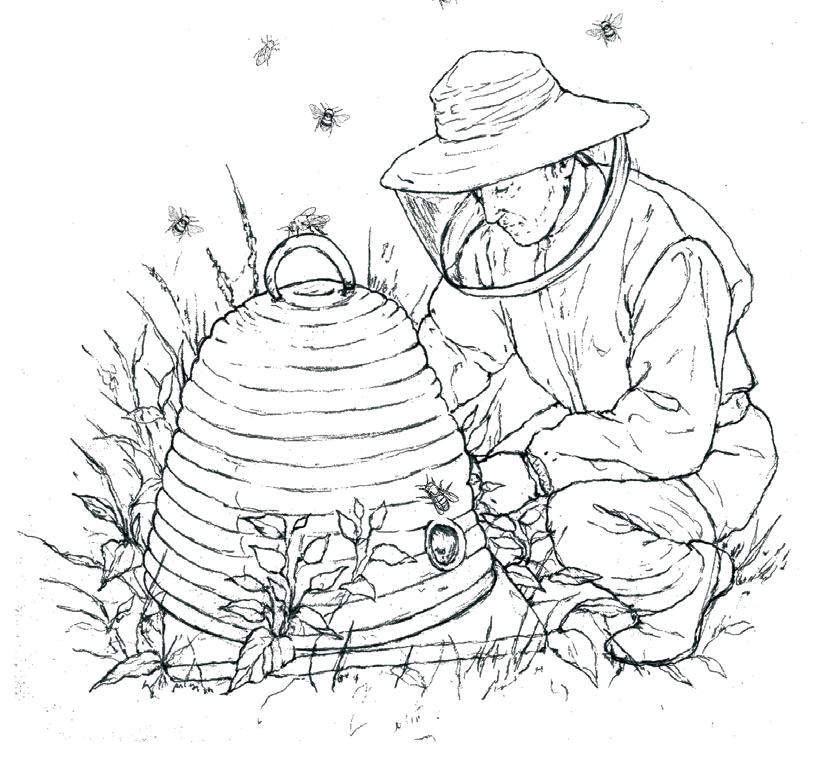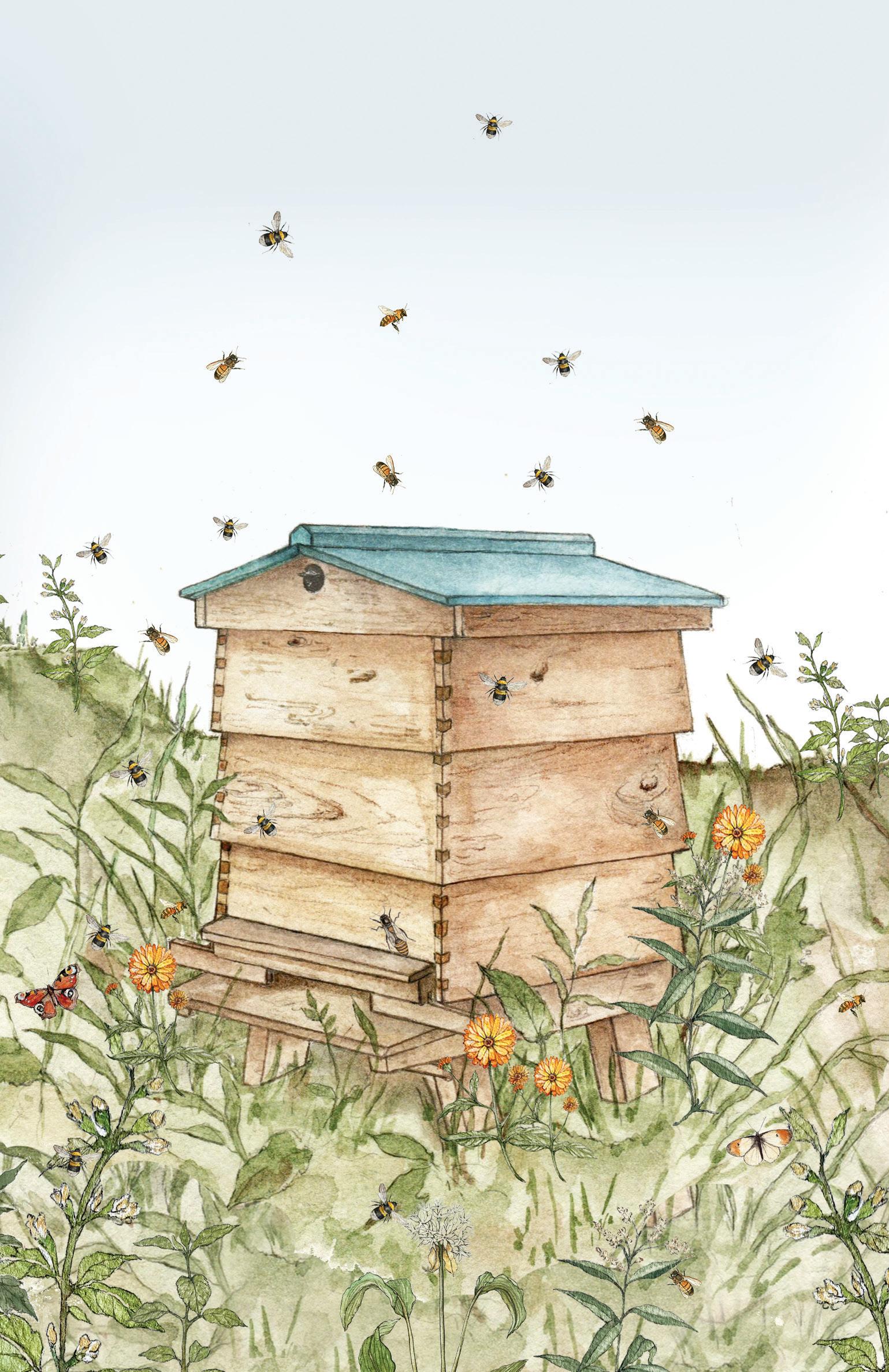Bees and Beekeeping in Irish Folklore Eimear Chaomhánach
Illustrated by Jane Carkill
First published 2024 by The O’Brien Press Ltd, 12 Terenure Road East, Rathgar, Dublin 6, D06 HD27, Ireland.
Tel: +353 1 4923333; Fax: +353 1 4922777
E-mail: books@obrien.ie
Website: obrien.ie
The O’Brien Press is a member of Publishing Ireland.
ISBN: 978-1-78849-523-3
Text © Eimear Chaomhánach 2024
Illustrations © Jane Carkill 2024
The moral rights of the author and illustrator have been asserted.
The quotes from the poems ‘The Beekeeper to His Assistant’ and ‘The Silence After’ by Noel Duffy (published in London, Ward Wood Publishing, 1988) are reprinted with the kind permission of Noel Duffy & Ward Wood Publishing. If any involuntary infringement of copyright has occurred, sincere apologies are offered, and the owners of such copyright are requested to contact the publisher.
Editing, design and layout © The O’Brien Press 2024
Cover and text design by Emma Byrne
All rights reserved. No part of this publication may be reproduced or utilised in any form or by any means, electronic or mechanical, including for text and data mining, training artificial intelligence systems, photocopying, recording or in any information storage and retrieval system, without permission in writing from the publisher.
1 3 5 7 6 4 2 25 27 28 26 24
Printed and bound by by L&C Printing Group, Poland. The paper in this book is produced using pulp from managed forests.
Published in
With love to my dad, Pat Kavanagh, beekeeper
AcknOWledgements
I would like to thank those who encouraged, supported and facilitated my return to the treasure trove that is the folklore of beekeeping.
Firstly, a huge thanks to the staff of the National Folklore Collection, University College Dublin (UCD), who nurtured my initial love of folklore, facilitated the distribution of a questionnaire for research purposes and were immediately helpful in terms of referencing their manuscript collections in these pages. I would like to thank Christina Brophy, my fellow folklorist, who initiated our road trips twenty years ago, proofread my original thesis and encouraged my return to folklore in recent years.
I would like to thank the British Beekeepers Association for allowing me to quote from and reference the British Bee Journal, a publication now in their care. Thanks also to the wonderful poet Noel Duffy, who graciously gave his permission to include two of his poems here.
I am very grateful to all at The O’Brien Press, in particular Kunak McGann and Kasandra Ferguson, who saw the potential in my manuscript, Jane Carkill for her ethereal illustrations, Emma Byrne for her design and Paula Elmore
who expertly asked the right questions during the editing process.
To my husband, Dec, who skilfully balanced giving me the time I needed alongside getting directly involved by proofreading a final edit and providing excellent feedback, cautiously!
To Sinéad, who fulfils the role of beloved sister and best friend, and who stayed with me, chapter by chapter, to give her insight, unwaning support and daily conversation, which triggered the most gorgeous memories of growing up together in a beekeeping household.
It goes without saying that Dad is the inspiration and explanation as to why bees are so important to me. An intrinsic aspect of getting this book published, however, is down to my mother, Margaret Kavanagh, who instilled in me a drive to get things done, and who I know would be very proud of this moment.
INTRODUCTION
Bees and beekeeping are woven deep into the fabric of my life, from as early as I can remember. My father, Pat, has practised beekeeping since he was fourteen years old. But it is more than a practice: it is the core of his existence, deeply anchored in story and in parcels of knowledge passed down through the generations. I cannot separate the man from the bees.
The youngest of four siblings, I was reared with my sisters in a household that was finely tuned to the rhythm of the annual beekeeping calendar. Beekeeping practices work in tandem with Ireland’s changeable weather patterns. Unpredictable weather affects the start and end of the beekeeping season and, naturally, this affects the amount of honey produced by the bees and collected by the keeper.
As a child, I remember Dad remaining vigilant during winter months and making biweekly visits to his hives in Dundrum, Kilgobbin and Enniscorthy. He safeguarded against a hive perishing during colder weather and monitored whether a box hive had been encroached on by
Introduction an enterprising mouse. Come February, he would begin preparation for the ensuing year, which involved repairing combs, strengthening bee boxes and assembling new frames.
During the summer months, he attended to his hives daily and toiled for long hours. Warm weather often triggers swarming and my father would happily collect unwanted swarms from local gardens. I would tag along, equipped with the required paraphernalia to collect the swarm: a white sheet, a cardboard box and, very importantly, a smoker to calm the upset bees. As Dad’s helper, I would be on standby as he coaxed the swarm into a cardboard box, keeping the smoker lit and being ready with the white sheet to gently envelop the swarm.
Throughout May and June, Dad would continually repair, improve and enhance healthy hives. In a good season, honey was extracted from stronger hives and replaced with fresh combs to enable the bees to continue their labour. Come September, Dad would well and truly need a rest. With autumn came respite: the worker bees were less industrious as nectar supplies dwindled. In October, he made preparations for the ensuing winter. And so, the cycle continued.
My father kept three working hives in our back garden in Dundrum. Being a small garden of a semi-detached house in a large estate, this brought with it many a sting
The Keeper of the Bees
as my sisters, cousins and I played close to the beehives. Looking back, I do not remember having a sense of fear around bees. We were informed that we would only be stung if we aggravated the bees or got in their way. As such, we understood that if we got stung it was our fault. It was at this early stage that we recognised the importance of not interfering with the work of the hive and developed a respect for the bees that, in my case, would last a lifetime.
On Sundays, a frequent family outing for us was visiting Dad’s apiary in Ballycorus in the Dublin Mountains, where he kept approximately fifteen hives. It was there we met Larry Dunne, a pig farmer, who was one of the first people I interviewed as a budding folklorist during my Bachelor of Arts in Irish Folklore. As part of my undergraduate study in Irish Folklore in UCD, I wrote an essay on the myths, lore and legends associated with beekeeping. This is when I began collecting folklore and musings from Dad for the first time. Unbeknownst to either of us, his approach to beekeeping was imbued with folkloric practices inherited from his father, himself a beekeeper, from Ballindaggan, County Wexford.
A few years later, I returned to my study of the folklore of bees and completed a two-year master’s on the lore of bees, their keepers and produce in Irish folk tradition. I
Introduction
had the great fortune to have Dr Dáithí Ó hÓgáin as my supervisor. He was a renowned folklorist, author, poet and mentor. Dáithí encouraged me to look beyond the confines of my academic study and continue my exploration of the lore of beekeeping. Twenty years on, I have returned to my initial study, which continues to bring me joy.
In these pages, I present the folklore, customs, beliefs and traditions associated with bees; while much information about the practice of beekeeping may be gleaned, it is not my intention to provide a guide to beekeeping. I have delved deep into the manuscript collections contained in the wonderful archive of the National Folklore Collection (NFC) in UCD. I distributed a questionnaire nationally via the NFC and travelled across Ireland with a fellow folklorist, Christina Brophy, collecting stories from people who were generous enough to share their recollections. Predominantly, I have collected folklore and memories from Dublin, Wexford, Wicklow, Cork and Kerry. For this reason, it is Irish traditions and Irish customs that are at the core of this exploration, with international folklore peppered throughout to demonstrate similarities and contrasts.
In both Irish and international folklore, a common theme prevails: bees have been revered as almost sacred in nature for centuries. This veneration for bees is proudly celebrated in folklore and is evidenced by bees having their own patron
The
Keeper of the Bees
saint, Gobnait. Legend describes the origin of bees on earth and their arrival into Ireland as a divine intervention. This sense of the sacred permeates their by-products – honey and wax – to which healing powers are attributed. The bees’ ability to run an industrious hive, construct a perfectly hexagonal comb and communicate through their own unique method of movement offers a reason as to why, in folklore, bees are portrayed as the most intelligent of all species.
Bees are considered to be all-knowing and perceptive creatures, and we witness humans deferring to bees for their advice. Since the days of Ancient Greece, bees have been represented as intelligent creatures, as seen in the folktale depicting the bees outsmarting Greek philosopher Aristotle. Irish tradition offers a unique version of the tale of Aristotle and the bees, one that aptly shows how stories transmitted by the oral tradition can be imbued with distinct and unique variations.
As bees are beheld as an intelligent and gentle species, it follows that bees have been respected as trusted indicators of good luck or misfortune. Beekeepers value their bees to such an extent that they integrate them into their family life. It is considered a polite act to inform bees of important household events, such as weddings, births and deaths. This practice, known as ‘telling the bees’, is commonly carried out to this day, nationally and internationally. When my beloved
mum died, Dad dutifully informed his bees of her passing. In keeping with the folkloric tradition, my father thought it was the right thing to do and that, had he failed to do so, his sensitive bees might rise and abandon the household.
The special relationship that exists between the bee and its keeper has a rich and pervasive presence within lore and legend. I have had the fortune to witness the gentle nature of this connection first-hand when observing Dad amongst his bees. His innate sensibility around his bees means he can determine their mood as soon as he lifts the lid off a hive. In these pages, I hope to share his acute understanding of bees, a holistic approach that cannot be learned through a beekeeping manual. It is an allegiance that has evolved from decades of caring for bees and being in their company. And so, this book is dedicated to and is an ode to my dad, Pat Kavanagh, a beekeeper since 1954.






